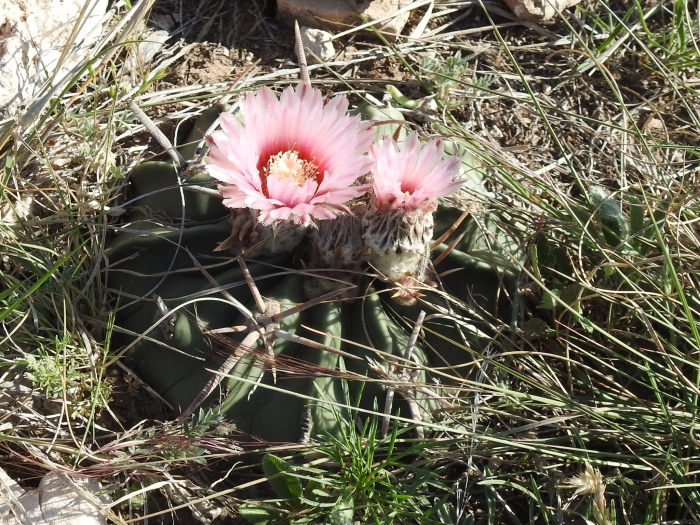Horse Crippler
(Echinocactus texensis)
Horse Crippler (Echinocactus texensis)
/
/

Sam Kieschnick
CC BY 4.0
Image By:
Sam Kieschnick
Recorded By:
Copyright:
CC BY 4.0
Copyright Notice:
Photo by: Sam Kieschnick | License Type: CC BY 4.0 | License URL: http://creativecommons.org/licenses/by/4.0/ | Rights Holder: Sam Kieschnick | Publisher: iNaturalist | Date Created: 2018-04-04T05:58-07:00 |



















Estimated Native Range
Summary
Echinocactus texensis, commonly known as Horse Crippler, is a slow-growing, perennial cactus native to arid regions, including grasslands, rocky plains, and desert scrub in the southern United States and northeastern Mexico. This cactus typically remains low to the ground, reaching a height of 6 to 15 inches (15 to 38 cm) with a similar width, and has a distinctive, flattened globose shape. The plant is covered in stout, sharp spines that can pose a hazard to animals and humans, hence its common name. Horse Crippler blooms in late spring to early summer, producing large, showy, pink to magenta flowers that are quite attractive when in bloom.
Echinocactus texensis is valued for its unique form and striking flowers, making it a popular choice for rock gardens, xeriscaping, and as a specimen plant in cactus and succulent collections. It requires minimal maintenance once established and is drought-tolerant, needing only occasional watering. The cactus prefers full sun exposure and thrives in well-draining soils. While generally disease-resistant, it can be susceptible to root rot if overwatered or if the soil does not drain properly. Due to its spines, it should be planted where it will not be a hazard to passersby.CC BY-SA 4.0
Echinocactus texensis is valued for its unique form and striking flowers, making it a popular choice for rock gardens, xeriscaping, and as a specimen plant in cactus and succulent collections. It requires minimal maintenance once established and is drought-tolerant, needing only occasional watering. The cactus prefers full sun exposure and thrives in well-draining soils. While generally disease-resistant, it can be susceptible to root rot if overwatered or if the soil does not drain properly. Due to its spines, it should be planted where it will not be a hazard to passersby.CC BY-SA 4.0
Plant Description
- Plant Type: Succulent
- Height: 0.5-0.6 feet
- Width: 1-1.25 feet
- Growth Rate: Slow
- Flower Color: Pink, Purple, Red, Yellow
- Flowering Season: Spring, Summer
- Leaf Retention: Evergreen
Growth Requirements
- Sun: Full Sun
- Water: Low
- Drainage: Fast, Medium
Common Uses
Border Plant, Drought Tolerant, Low Maintenance, Rock Garden, Showy Flowers
Natural Habitat
Native to grasslands, rocky plains, and desert scrub in the southern United States and northeastern Mexico
Other Names
Common Names: Horse Crippler, Texas Barrel Cactus, Devil’s Pincushion, Devil’s-Head Cactus, Horse-Crippler Cactus, Mancacaballo, Monco Caballo, Devil’s Head
Scientific Names: , Echinocactus texensis, Echinocactus courantianus, Echinocactus courantianus, Echinocactus lindheimeri, Echinocactus platycephalus, Echinocactus texensis, Echinocactus texensis var. gourgensii, Echinocactus texensis var. gourgensii, Echinocactus texensis var. longispinus
GBIF Accepted Name: